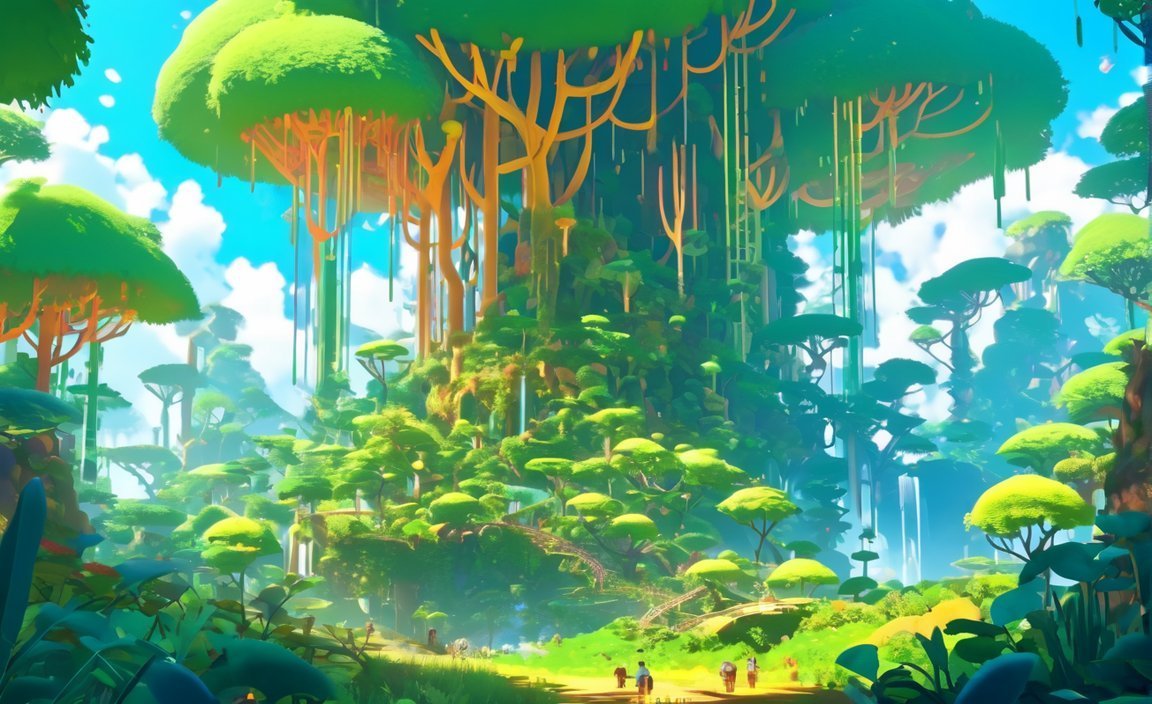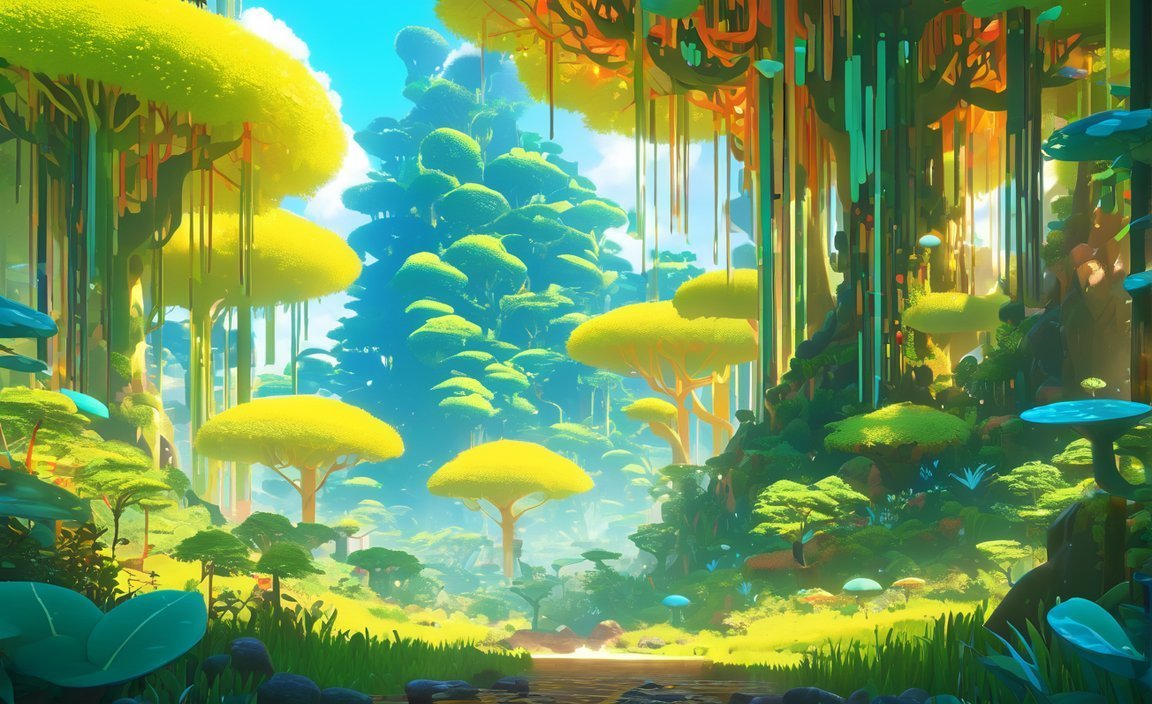Welcome to [10 Fascinating Biome Facts: Discover the Wonders of Earth’s Diverse Habitats!], where we delve into the fascinating world of Earth’s diverse biomes. From the expansive ocean to the lush tropical rainforests and the mysterious depths of the taiga, these remarkable habitats play a crucial role in sustaining life on our planet. Join us as we uncover intriguing facts about these biomes, revealing the hidden wonders and intricate connections that make them so extraordinary. Get ready to be captivated by the awe-inspiring beauty and astonishing biodiversity that exist within Earth’s vast array of biomes.

Key Takeaways:
- Grasslands are areas with abundant grasses found in various regions worldwide.
- Africa has the largest savanna biome, covering about half of the continent.
- Deserts, despite their harsh conditions, are home to incredible and unique animals.
- Shrublands are diverse ecosystems with vegetation that is neither too tall nor too short.
- The tundra is a cold and barren biome where massive herds of reindeer can be seen.
- The taiga biome, also known as the boreal forest, is home to many endangered animals.
- Temperate forests have dense canopies created by trees stretching towards the sun.
- Rainforests are renowned for their incredible biodiversity, with the possibility of encountering wrestling frogs.
10 Facts About Biomes
Biomes are fascinating and diverse habitats that play a crucial role in the overall balance of our planet’s ecosystem. From the grasslands to the rainforests, each biome has its unique characteristics and supports a wide variety of plants and animals. In this article, we will delve into the wonders of Earth’s diverse biomes and uncover 10 captivating facts that will leave you in awe.
1. Grasslands: Wide Open Spaces
Grasslands, as the name suggests, are vast areas dominated by grasses, with few trees and shrubs. They can be found in different parts of the world and are home to a remarkable array of wildlife. Did you know that the African savanna biome covers about half of the continent and is famous for its iconic animals like lions, elephants, and giraffes?
2. Deserts: A World of Surprises
Deserts may seem harsh and lifeless, but they harbor some of the most incredible and unique animals. From the swift and adaptable camels to the elusive and nocturnal fennec fox, deserts have evolved remarkable strategies to survive in their extreme environments. It’s a world full of surprises and adaptations!
3. Shrublands: A Perfect Balance
Shrublands, also known as chaparral or scrubland, are diverse ecosystems characterized by vegetation that falls between tall forests and low grasslands. These biomes are found in areas with moderate rainfall and often experience seasonal droughts. Shrublands strike a perfect balance between providing habitat for animals and being relatively resistant to fires.
4. Tundra: Harsh and Beautiful
The tundra is a cold and barren biome that can be found in the northernmost regions of the world. Its frigid temperatures and short growing seasons make it a challenging environment for both plants and animals. However, the tundra is home to massive herds of reindeer and other unique species that have adapted to survive in this harsh yet stunning landscape.
5. Taiga: Boreal Forests in Peril
The taiga biome, also known as the boreal forest, spans across the northern regions of North America, Europe, and Asia. It is the largest terrestrial biome on Earth, but it is also facing significant threats. Many endangered animals, such as the Siberian tiger and the Canadian lynx, call the taiga their home, making its preservation a matter of utmost importance.
6. Temperate Forests: A Canopy of Life
In temperate forests, trees stretch towards the sun, creating a dense canopy that shades the forest floor. These biomes can be found in parts of North America, Europe, and Asia. They support a wide variety of plants and animals, from towering oak trees to tiny woodland creatures. Exploring a temperate forest is like diving into a vibrant, green world full of life.
7. Rainforests: Biodiversity Hotspots
Rainforests are known for their incredible biodiversity, with millions of species of plants, animals, and microorganisms calling these biomes their home. Did you know that the Amazon rainforest alone is estimated to contain 10% of the world’s known species? From colorful birds to secretive big cats, rainforests are truly biodiversity hotspots that deserve our utmost attention and protection.
8. Wrestling Frogs and More
When you venture into the depths of a rainforest, you might stumble upon some extraordinary and peculiar creatures. For instance, did you know that there are frogs in the rainforests of Ecuador that engage in “wrestling” behavior to defend their territories? These fascinating interactions are just a glimpse of the intricate web of life that exists within rainforests.
9. Coral Reefs: Underwater Oasis
While not technically considered biomes, coral reefs are vibrant underwater ecosystems that deserve a mention. These stunningly beautiful habitats teem with life, creating a kaleidoscope of colors beneath the waves. Coral reefs provide critical habitats for countless species, and their preservation is essential for the overall health of our planet’s oceans.
10. Threats to Biomes: Time to Take Action
Despite their importance, biomes all over the world face numerous threats. Deforestation, climate change, pollution, and habitat destruction put these delicate ecosystems at risk. It is crucial that we take action to protect and conserve these irreplaceable natural treasures for future generations to enjoy.
In conclusion, biomes are not just ordinary habitats. They are intricate, unique, and essential parts of our planet’s intricate tapestry of life. From the grasslands to the rainforests and everything in between, each biome is a world of wonders waiting to be explored. Let us marvel at the incredible diversity of life that these biomes contain and work towards their preservation and conservation. Our planet’s future depends on it.
Check out these ten fascinating facts about condensation! If you’re curious about the science behind it, click here to learn more.
Did you know that marine biology is full of incredible discoveries? Dive into these ten mind-blowing facts to uncover the wonders of the ocean! Find out more here.
Discover the amazing world of marine life with these ten incredible facts! From colorful coral reefs to fascinating creatures, you won’t believe what lies beneath the surface. Dive deeper here.
Explore the wonders of ocean life with these ten fascinating facts! From mysterious deep-sea creatures to breathtaking underwater ecosystems, the ocean holds endless surprises. Get ready for an underwater adventure here.
Step into the enchanting world of temperate deciduous forests with these ten captivating facts! From changing seasons to diverse flora and fauna, these forests have so much to offer. Embark on a journey here.
Did you know that temperate forests are home to a wealth of natural wonders? Uncover the secrets of these incredible ecosystems with these ten eye-opening facts. Delve deeper here.
Venture into the lush world of temperate rainforests and discover ten astounding facts about these unique ecosystems. From towering trees to abundant biodiversity, there’s so much to explore. Start your adventure here.
Embark on a thrilling journey through the African savanna and uncover ten awe-inspiring facts about this incredible habitat. From majestic wildlife to stunning landscapes, prepare to be amazed. Begin your safari here.
Dive into the captivating world of marine life and learn ten fascinating facts that will leave you in awe. From vibrant coral reefs to magnificent marine creatures, the ocean is teeming with wonders. Dive deeper into the blue here.
Discover the wonders of ocean animals with these ten mind-boggling facts! From playful dolphins to mesmerizing sea turtles, you’ll be amazed by the incredible diversity of marine creatures. Dive in here.
Explore the untamed beauty of the tropical savanna with these ten incredible facts. From towering grasslands to iconic wildlife, this vibrant biome will leave you breathless. Start your adventure here.
The bottom of the ocean has thriving communities.
Did you know that the depths of the ocean are teeming with life? While it may seem like a desolate place, the bottom of the ocean actually harbors thriving communities that are essential to the health of our planet. Here are 10 fascinating facts about the bottom of the ocean and the diverse communities that call it home.
1. Hydrothermal vents: The hotspots of life
At the bottom of the ocean, there are hydrothermal vents, which are small underwater volcanoes that spew hot water, gases, and chemicals. These vents create a unique environment where heat-loving bacteria thrive, forming the base of a rich food chain. Despite extreme conditions, diverse organisms, including giant tube worms, crabs, and clams, have adapted to survive and flourish near these vents.
2. Biodiversity in the abyss
The deep-sea floor, known as the abyssal plain, may seem dark and inhospitable, but it supports a surprising amount of life. From vibrant corals and sponges to elusive species like the fangtooth fish and the viperfish, the abyssal plain hosts a remarkable diversity of organisms. Many of these deep-sea species have unique adaptations to survive the immense pressure, lack of light, and scarcity of food.
3. Coral reefs: Colorful oases in the deep
While coral reefs are not technically considered biomes, they are incredibly diverse and form vital ecosystems. Found in shallow and deep waters, coral reefs provide critical habitat for countless species. Despite the challenges they face, such as rising ocean temperatures and pollution, vibrant coral reefs are true wonders of the ocean’s bottom.
4. Deep-sea giants
The ocean floor is home to some of the largest and most fascinating creatures on Earth. From the colossal squid, which can grow up to 43 feet long, to the mysterious giant isopod, the deep-sea giants captivate our imaginations. These extraordinary organisms have evolved unique adaptations to thrive in the cold and dark depths of the ocean.
5. Adaptations for survival
Life at the bottom of the ocean has inspired remarkable adaptations. With limited or no access to sunlight, many organisms have developed bioluminescent capabilities to communicate, attract prey, or deter predators. Others have evolved novel sensory organs to navigate in darkness or find food in unconventional ways. These adaptations showcase the wonders of evolution and the ingenuity of nature.
6. Deep-sea exploration: Unlocking the mysteries
Despite our fascination with the deep sea, we have only scratched the surface of its exploration. The vast majority of the ocean floor remains unexplored, and new discoveries are constantly being made. The advancements in technology, like remotely operated vehicles and deep-sea submersibles, have allowed us to delve deeper into the mysteries of the ocean’s bottom and uncover its hidden secrets.
7. Threats to deep-sea communities
Unfortunately, the bottom of the ocean and its thriving communities face numerous threats. Climate change, pollution, overfishing, and deep-sea mining activities pose significant risks to these delicate ecosystems. It is crucial for us to understand and mitigate these impacts to protect the biodiversity and ecological balance of the ocean’s depths.
8. The importance of deep-sea ecosystems
The bottom of the ocean plays a vital role in Earth’s overall health and well-being. These ecosystems contribute to the global carbon cycle, provide habitat for countless species, and support commercially valuable fisheries. They also act as carbon sinks, helping to regulate the planet’s climate. Preserving and conserving the bottom of the ocean is critical for maintaining the balance of our planet’s ecosystems.
9. Collaboration for conservation
Given the immense scale and complexity of the ocean, conservation efforts require international collaboration and cooperation. Governments, scientists, conservation organizations, and individuals all have a role to play in protecting and preserving the bottom of the ocean. By working together, we can ensure the future health and biodiversity of these vital ecosystems.
10. Exploring the ocean’s wonders
The wonders of the ocean’s depths continue to fascinate and inspire us. Through ongoing research and exploration, we are gaining a deeper understanding of the bottom of the ocean and the thriving communities that inhabit it. By sharing knowledge and promoting awareness, we can foster a sense of stewardship and instigate positive change to safeguard these extraordinary environments.
Key Takeaways:
- The bottom of the ocean is home to thriving communities around hydrothermal vents and on the abyssal plain.
- Biodiversity in the deep sea is remarkable, with unique adaptations for survival in extreme conditions.
- Coral reefs, although not technically biomes, are diverse and crucial ecosystems in the ocean.
- Deep-sea giants, such as the colossal squid and giant isopod, capture our imagination.
- Adaptations like bioluminescence and sensory organs enable organisms to thrive in darkness.
- Ongoing deep-sea exploration continues to unravel the mysteries of the ocean’s bottom.
- Threats such as climate change, pollution, and overfishing endanger deep-sea communities.
- The ocean’s bottom plays a crucial role in global carbon cycling and climate regulation.
- Collaborative efforts are essential for conserving and protecting these delicate ecosystems.
- By promoting knowledge and awareness, we can inspire action to preserve the wonders of the ocean.
Citation:
– Marine Insight, “Facts You Need to Know About Marine Biome”
– NASA Climate Kids, “Vent Mysteries”
The taiga is the largest terrestrial biome
The taiga biome, also known as the boreal forest, holds the title for being the largest terrestrial biome on our planet. Spanning across Europe, North America, and Asia, this remarkable biome covers approximately 11.5% of Earth’s land area. Let’s delve into some fascinating facts about the taiga and its significance in our ecosystem.
1. A Natural Landscape
Taiga biomes are characterized by unbroken natural landscapes, devoid of significant human development or habitat fragmentation. These forest ecosystems and their plant communities create a mesmerizing tapestry of unspoiled wilderness.
2. A Permanently Frosty Ground
In the taiga, the presence of permafrost is a defining feature. Permafrost comes in two forms: continuous and discontinuous. It further adds to the unique and challenging environment of the taiga.
3. The Dance of Light and Darkness
Life in the taiga revolves around extremes of daylight. Some regions of the taiga experience the phenomenon of the midnight sun during the summer, where the sun never sets, while others undergo the polar night in winter, where the sun never rises. These cyclical patterns shape the behavior and adaptations of the organisms that call the taiga home.
4. Shaped by Ancient Glaciers
Glaciers played a significant role in shaping the taiga we see today. During the last Ice Age, massive formations of ice covered parts of the modern taiga. These glaciers acted as formidable bulldozers, plowing away the soil as they advanced.
5. A Dry Biome
Contrary to popular belief, the taiga is one of the driest places on Earth after deserts. Precipitation is generally low, with up to 1 meter of rainfall per year, primarily during the summer. The scarcity of rain makes adapting to the taiga’s moderate drought conditions a challenge for its inhabitants.
6. Biodiversity Abounds
The taiga is teeming with a rich variety of species. Coniferous trees, such as spruces, pines, and firs, dominate the landscape, creating a unique forest environment. Besides trees, mosses and lichens also find their home in the taiga. Moreover, an impressive array of animals, including reindeer, moose, wolves, bears, and more, can be found thriving here.
7. Vital Ecological Roles
Beyond its sheer size, the taiga plays a critical role in Earth’s ecosystem. It acts as a significant carbon sink, absorbing large amounts of carbon dioxide from the atmosphere. As such, the preservation of the taiga is crucial in combating climate change. Additionally, this vast biome contributes to the maintenance of global biodiversity.
8. Nature’s Way of Renewal: Fire
Fires are a natural part of the taiga ecosystem and serve a vital purpose. They help clear out old and sick trees, rejuvenating the forest and ensuring the overall health of the biome. Given that most plants in the taiga are coniferous, this is why it is often referred to as the coniferous forest.
9. Soil Challenges
Due to the scarcity of grazing animals and limited nutrient cycling, the taiga has poor soil quality. However, in some areas, deciduous trees and plants manage to thrive, enriching the soil with organic matter and nutrients.
10. A Beauty Worth Protecting
The taiga’s sheer expanse, unique adaptations, and biological significance make it a biome of immense value. As the largest terrestrial biome on Earth, its preservation and protection are essential for the well-being of our planet and the countless species that rely on it.
These ten facts about the taiga biome shed light on its vast scope and importance, inviting us to appreciate and safeguard this awe-inspiring habitat.
Key Takeaways:
– The taiga, or boreal forest, is the largest terrestrial biome.
– It covers approximately 11.5% of Earth’s land area and extends across Europe, North America, and Asia.
– Taiga biomes feature unbroken natural landscapes without major human development.
– Permafrost is a notable feature, varying from continuous to discontinuous.
– Some parts of the taiga experience the midnight sun during summer and the polar night in winter.
– Glaciers shaped the taiga during the last Ice Age, plowing away soil as they advanced.
– The taiga receives limited precipitation, making it one of the driest places on Earth.
– High species richness exists in the taiga, including coniferous trees, mosses, lichens, and various animal species.
– The taiga plays crucial roles in Earth’s ecosystem, acting as a carbon sink and supporting biodiversity.
– Fire is an essential part of the taiga, aiding in the renewal and health of the forest.
– The taiga faces challenges due to poor soil quality but supports deciduous trees in some areas.
Sources:
– facts.net: Taiga Biomes Facts
– softschools.com: Taiga Biome Facts

FAQ
Q1: What is the largest biome on Earth?
A1: The marine biome, which covers about 70% of the Earth’s surface, is the largest biome on Earth.
Q2: Where can you find the most diverse species of plants and animals?
A2: Tropical rainforests, specifically the ones in the ocean, are home to half of the world’s species and are known for their incredible biodiversity.
Q3: Are there thriving communities at the bottom of the ocean?
A3: Yes, the bottom of the ocean has thriving communities around hydrothermal vents, which are small underwater volcanoes that spew hot water, gases, and chemicals.
Q4: Which is the largest terrestrial biome?
A4: The taiga biome, also known as the boreal forest, is the largest terrestrial biome and extends across Europe, North America, and Asia.
Q5: What are some common features of the taiga biome?
A5: The taiga biome is characterized by its coniferous trees, mosses, lichens, and various animal species such as reindeer, moose, wolves, and bears.
- Sept 31 Myth: Unveiling Calendar Secrets - March 18, 2025
- How Long & Till December 18, 2025: Accurate Countdown Guide - March 18, 2025
- Discover Japanese Artists: A Complete History - March 18, 2025
















